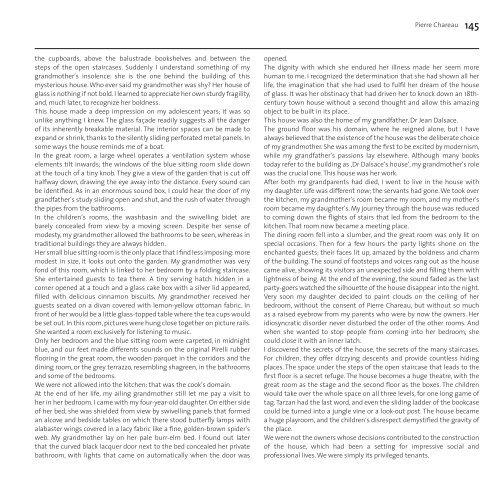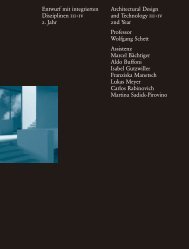Layout LC.indd - Professur Schett
Layout LC.indd - Professur Schett
Layout LC.indd - Professur Schett
Sie wollen auch ein ePaper? Erhöhen Sie die Reichweite Ihrer Titel.
YUMPU macht aus Druck-PDFs automatisch weboptimierte ePaper, die Google liebt.
the cupboards, above the balustrade bookshelves and between the<br />
steps of the open staircases. Suddenly I understand something of my<br />
grandmother‘s insolence: she is the one behind the building of this<br />
mysterious house. Who ever said my grandmother was shy? Her house of<br />
glass is nothing if not bold. I learned to appreciate her own sturdy fragility,<br />
and, much later, to recognize her boldness.<br />
This house made a deep impression on my adolescent years; it was so<br />
unlike anything I knew. The glass façade readily suggests all the danger<br />
of its inherently breakable material. The interior spaces can be made to<br />
expand or shrink, thanks to the silently sliding perforated metal panels. In<br />
some ways the house reminds me of a boat.<br />
In the great room, a large wheel operates a ventilation system whose<br />
elements tilt inwards; the windows of the blue sitting room slide down<br />
at the touch of a tiny knob. They give a view of the garden that is cut off<br />
halfway down, drawing the eye away into the distance. Every sound can<br />
be identifi ed. As in an enormous sound box, I could hear the door of my<br />
grandfather‘s study sliding open and shut, and the rush of water through<br />
the pipes from the bathrooms.<br />
In the children‘s rooms, the washbasin and the swivelling bidet are<br />
barely concealed from view by a moving screen. Despite her sense of<br />
modesty, my grandmother allowed the bathrooms to be seen, whereas in<br />
traditional buildings they are always hidden.<br />
Her small blue sitting room is the only place that I fi nd less imposing: more<br />
modest in size, it looks out onto the garden. My grandmother was very<br />
fond of this room, which is linked to her bedroom by a folding staircase.<br />
She entertained guests to tea there. A tiny serving hatch hidden in a<br />
corner opened at a touch and a glass cake box with a silver lid appeared,<br />
fi lled with delicious cinnamon biscuits. My grandmother received her<br />
guests seated on a divan covered with lemon-yellow ottoman fabric. In<br />
front of her would be a little glass-topped table where the tea cups would<br />
be set out. In this room, pictures were hung close together on picture rails.<br />
She wanted a room exclusively for listening to music.<br />
Only her bedroom and the blue sitting room were carpeted, in midnight<br />
blue, and our feet made differents sounds on the original Pirelli rubber<br />
fl ooring in the great room, the wooden parquet in the corridors and the<br />
dining room, or the grey terrazzo, resembling shagreen, in the bathrooms<br />
and some of the bedrooms.<br />
We were not allowed into the kitchen: that was the cook‘s domain.<br />
At the end of her life, my ailing grandmother still let me pay a visit to<br />
her in her bedroom. I came with my four-year-old daughter. On either side<br />
of her bed, she was shielded from view by swivelling panels that formed<br />
an alcove and bedside tables on which there stood butterfl y lamps with<br />
alabaster wings covered in a lacy fabric like a fi ne, golden-brown spider‘s<br />
web. My grandmother lay on her pale burr-elm bed. I found out later<br />
that the curved black lacquer door next to the bed concealed her private<br />
bathroom, with lights that came on automatically when the door was<br />
Pierre Chareau<br />
145<br />
opened.<br />
The dignity with which she endured her illness made her seem more<br />
human to me. I recognized the determination that she had shown all her<br />
life, the imagination that she had used to fulfi l her dream of the house<br />
of glass. It was her obstinacy that had driven her to knock down an 18thcentury<br />
town house without a second thought and allow this amazing<br />
object to be built in its place.<br />
This house was also the home of my grandfather, Dr Jean Dalsace.<br />
The ground fl oor was his domain, where he reigned alone, but I have<br />
always believed that the existence of the house was the deliberate choice<br />
of my grandmother. She was among the fi rst to be excited by modernism,<br />
while my grandfather‘s passions lay elsewhere. Although many books<br />
today refer to the building as ‚Dr Dalsace‘s house‘, my grandmother‘s role<br />
was the crucial one. This house was her work.<br />
After both my grandparents had died, I went to live in the house with<br />
my daughter. Life was different now; the servants had gone. We took over<br />
the kitchen, my grandmother‘s room became my room, and my mother‘s<br />
room became my daughter‘s. My journey through the house was reduced<br />
to coming down the fl ights of stairs that led from the bedroom to the<br />
kitchen. That room now became a meeting place.<br />
The dining room fell into a slumber, and the great room was only lit on<br />
special occasions. Then for a few hours the party lights shone on the<br />
enchanted guests; their faces lit up, amazed by the boldness and charm<br />
of the building. The sound of footsteps and voices rang out as the house<br />
came alive, showing its visitors an unexpected side and fi lling them with<br />
lightness of being. At the end of the evening, the sound faded as the last<br />
party-goers watched the silhouette of the house disappear into the night.<br />
Very soon my daughter decided to paint clouds on the ceiling of her<br />
bedroom, without the consent of Pierre Chareau, but without so much<br />
as a raised eyebrow from my parents who were by now the owners. Her<br />
idiosyncratic disorder never disturbed the order of the other rooms. And<br />
when she wanted to stop people from coming into her bedroom, she<br />
could close it with an inner latch.<br />
I discovered the secrets of the house, the secrets of the many staircases.<br />
For children, they offer dizzying descents and provide countless hiding<br />
places. The space under the steps of the open staircase that leads to the<br />
fi rst fl oor is a secret refuge. The house becomes a huge theatre, with the<br />
great room as the stage and the second fl oor as the boxes. The children<br />
would take over the whole space on all three levels, for one long game of<br />
tag. Tarzan had the last word, and even the sliding ladder of the bookcase<br />
could be turned into a jungle vine or a look-out post. The house became<br />
a huge playroom, and the children‘s disrespect demystifi ed the gravity of<br />
the place.<br />
We were not the owners whose decisions contributed to the construction<br />
of the house, which had been a setting for impressive social and<br />
professional lives. We were simply its privileged tenants.






